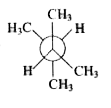How many isomeric alkenes are possible by the dehydration of 2,3-dimethyl butan-1-ol?
To determine how many isomeric alkenes can be formed by the dehydration of 2,3-dimethylbutan-1-ol, we will follow these steps:
Step 1: Draw the Structure of 2,3-Dimethylbutan-1-ol
The molecular structure of 2,3-dimethylbutan-1-ol can be represented as follows:
- The main chain is butane (4 carbon atoms).
- There are two methyl groups attached to the second and third carbon atoms.
- The hydroxyl (–OH) group is attached to the first carbon.
The structure can be depicted as:
CH3|CH3−CH−CH−CH2OH|CH3
Step 2: Dehydration Process
The dehydration of alcohols typically involves the removal of a water molecule (H2O) in the presence of an acid (like dilute HCl).
1. The hydroxyl group (–OH) will be protonated by the acid, making it a better leaving group.
2. Water is eliminated, leading to the formation of a carbocation.
Step 3: Identify the Carbocation
In this case, the dehydration will lead to the formation of a carbocation. The carbocation formed after the loss of water can be a primary or tertiary carbocation:
- The primary carbocation (less stable) can be formed at the first carbon.
- A more stable tertiary carbocation can be formed by rearrangement.
Step 4: Formation of Alkenes
From the carbocation, we can remove a proton (H+) to form alkenes:
1. From the primary carbocation:
- Removing a hydrogen from the adjacent carbon leads to one alkene.
2. From the tertiary carbocation:
- Removing a hydrogen from the adjacent carbon leads to another alkene.
Step 5: Identify Isomeric Alkenes
The possible alkenes formed from the dehydration of 2,3-dimethylbutan-1-ol are:
1. Alkene 1: Formed from the primary carbocation.
2. Alkene 2: Formed from the tertiary carbocation.
Conclusion
Thus, the total number of isomeric alkenes that can be formed from the dehydration of 2,3-dimethylbutan-1-ol is 2.
Final Answer
2 isomeric alkenes are possible.
---
The molecular structure of 2,3-dimethylbutan-1-ol can be represented as follows:
- The main chain is butane (4 carbon atoms).
- There are two methyl groups attached to the second and third carbon atoms.
- The hydroxyl (–OH) group is attached to the first carbon.
CH3|CH3−CH−CH−CH2OH|CH3
The dehydration of alcohols typically involves the removal of a water molecule (H2O) in the presence of an acid (like dilute HCl).
2. Water is eliminated, leading to the formation of a carbocation.
In this case, the dehydration will lead to the formation of a carbocation. The carbocation formed after the loss of water can be a primary or tertiary carbocation:
- The primary carbocation (less stable) can be formed at the first carbon.
- A more stable tertiary carbocation can be formed by rearrangement.
From the carbocation, we can remove a proton (H+) to form alkenes:
1. From the primary carbocation:
- Removing a hydrogen from the adjacent carbon leads to one alkene.
2. From the tertiary carbocation:
- Removing a hydrogen from the adjacent carbon leads to another alkene.
The possible alkenes formed from the dehydration of 2,3-dimethylbutan-1-ol are:
1. Alkene 1: Formed from the primary carbocation.
2. Alkene 2: Formed from the tertiary carbocation.
Thus, the total number of isomeric alkenes that can be formed from the dehydration of 2,3-dimethylbutan-1-ol is 2.
2 isomeric alkenes are possible.
Similar Questions
Knowledge Check
The most stable conformation of 2, 3-dimethyl butane is :
A B
B C
C Dnone of these
Dnone of these
How many chiral compounds are possible on monochlorination of 2-methyl butane
View SolutionTotal number of alkenes obtained by dehydration of 3,4-diethylhexan-2-ol in acidic medium ?
View SolutionHow many isomeric alkyne of hydrogenation gives 3,3 - Dimethylhexane.
View SolutionHow many structural isomeric alkenes on hydrogenation give −n-Pentane.
View SolutionHow many isomeric structural alkene on catalytic hydrogenation gives 3-Methyl hexane.
View SolutionHow many structurally isomeric dibromo butanes are possible.
View SolutionAcetaldehyde to butan-1-ol
View Solution


